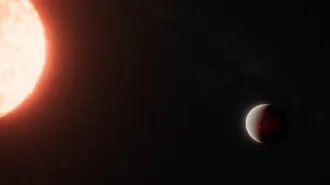Cosmologists say they’ve found compelling evidence that massive galaxies were already in place when the universe was less than a billion years old. Aided by vast amounts of unseen matter, these galaxies pulled in enough material to produce the cosmos’ first supermassive black holes and fuel the first quasars, the researchers report.
Astronomers have been astonishingly successful in finding distant quasars, beacons of light hundreds of times brighter than the galaxies in which they’re thought to reside. Some of these quasars are so remote that the light now reaching Earth was emitted when the universe was less than a billion years old.
The very existence of these ancient beacons has left astronomers with a challenge of cosmic proportions. They hold that the brightest quasars are fueled by supermassive black holes, the gravitational monsters that reside in galaxies a trillion times as massive as the sun. Could such galaxies have formed so soon after the Big Bang?
According to the prevailing cosmological model, the answer is yes–but only if dark matter, a type of invisible matter, makes up most of the mass in the universe.
In that case, vast dark-matter halos that surrounded each primordial galaxy would have pulled in the huge amounts of hydrogen gas necessary to form supermassive black holes and fuel quasars.
The infalling gas left a distinctive signature in the quasar light reaching Earth, two cosmologists assert in the Jan. 23 Nature. Indeed, the spectra of two of the most distant, and therefore earliest, known quasars display that signature, note Rennan Barkana of the Tel Aviv University in Israel and Abraham Loeb of the Harvard-Smithsonian Center for Astrophysics in Cambridge, Mass.
“If this signature is confirmed, it would provide the first observational evidence that quasars are embedded in great halos of dark matter,” says Laura Ferrarese of Rutgers University in Piscataway, N.J.
In their work, Barkana and Loeb considered the effect that infalling hydrogen gas would have on the light emitted by a distant, unusually bright quasar. In the vicinity of such a quasar, the beacon’s ultraviolet light would ionize all incoming hydrogen gas. Ionized gas can’t absorb radiation, so the quasar light would pass through that material unimpeded. But just outside that vicinity, the infalling gas would pile up and have sufficient density to avoid ionization and absorb a specific wavelength of light emitted by the quasar.
Spectra of two of the most distant quasars show such an absorption feature. From their analysis of these spectra, Barkana and Loeb calculate that each year, these two quasars’ galaxies pulled in hydrogen gas weighing 1,300 and 2,900 times the sun’s mass. At those rates, each galaxy could easily have formed the quasar and its black hole power source in just a few hundred million years.
At a meeting of the American Astronomical Society in Seattle earlier this month, a research team including George Djorgovski and Milan Bogosavljevic of the California Institute of Technology in Pasadena reported that a few other distant quasars show the absorption feature predicted by Barkana and Loeb.
The gas falling toward the most distant quasar known has such a high velocity that it suggests the beacon’s host galaxy resides in an extraordinarily dense region of space, Djorgovski says. That finding fits a popular model in which the earliest massive galaxies arose in the densest regions of the cosmos, over time becoming even more massive by consuming their smaller galactic neighbors, Loeb notes.
****************
If you have a comment on this article that you would like considered for publication in Science News, please send it to editors@sciencenews.org.







